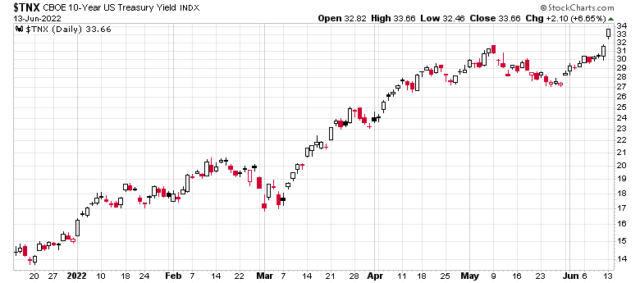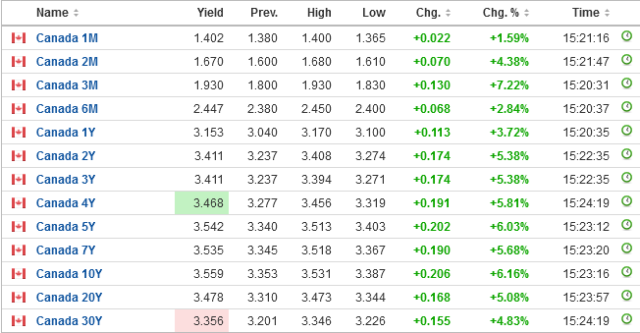I would be lying if I said the past week was pleasant, but one of the reasons why your portfolio decisions have some form of fundamental underpinnings is to just look at the quantitative situation instead of getting swayed by the emotions when you see the market value of the asset drop. Readers of Thaler (Misbehaving) can get a simple explanation of this mechanism – the pain of loss feels worse than the pleasure of gains.
One reason why people invest in real estate is because they do not have to concern themselves with a “mark to market” valuation of their properties on a daily basis. They take some form of comfort that their book value of their property remains the same, although the market is always acting on their pricing – just that there is no liquid market to shove the actual market value in front of your face all the time. I deeply suspect, for example, that many participants in the Vancouver and Toronto condominium markets know that the valuation of their properties have dropped in the past four months, but until they start seeing comparables, they are not mentally realizing it.
Private market equity has been another asset class that pension funds love to invest in because they can pretend to avoid market losses – you don’t lose money if you can’t sell it for a loss, right? Right???
Markets tend to have a momentum effect due to extrapolation of expectations by market participants. Strength begets strength, and weakness begets weakness. Valuations do become a corrective mechanism, but it is a very slow process to turn things around.
It is very easy to look at charts in retrospect, but nobody rings a bell when the ultimate tops are reached. Quite frankly I thought the momentum effect from all the quantitative easing would have carried forward into 2022 longer than it did, but the year to date has been a downhill march – the S&P 500 is down 23% and the TSX is down 11% year-to-date. The tech-heavier Nasdaq is down about 31%. Quantitative tightening has barely even begun, but the expectations of rate increases have clearly run its course.
Other cash-like asset classes have not fared well either – there have been few retreats other than straight cash. For instance, Bitcoin is down about 60% year-to-date. The Japanese Yen is down 15% vs. USD. Euro down 7% vs. USD. Long-term US Government debt (I will just use TLT as the proxy here) is down about 23%.
Price drops have even crept into some commodity markets. Copper is down 10%. Lumber is down about 50%.
The only remaining survivors I can find are the US Dollar (still going very strong despite inflation), Gold (roughly steady as measured in USD) and finally, oil (spot up 44%) and gas (up about 70%) are the clear outliers.
However, last week saw a very sharp correction in oil and gas. In the last week and a half, valuations of fossil fuel stocks have dropped 20% in a very short period of time.
A stock has its price drop for the simple reason that somebody is willing to unload it at a price lower than somebody is willing to purchase it. The question of why they are motivated to unload it comes generally in two forms. One is liquidity – the more motivated seller wants to sell it to the highest bidder right now, even if that high bid is at an unattractive price. These drops tend to be fueled by large hedge funds that are heavily leveraged and such drops are very sharp in nature – which is why I suspect the last week is partly fueled by deleveraging.
Another reason tends to be more valuation-focussed. In the case of fossil fuel stocks, if your raw input (commodity prices) decreases, then all things being equal, your equity value should decrease as well. So for instance, if crude oil drops 10%, your typical crude producer will drop a higher fraction due to the embedded operating and financial leverage in its business model. The announcement of the Freeport LNG facility being down for 3 months obviously did not help the North American natural gas marketplace, and hence the commodity is down about 30% from its recent highs – just under two weeks ago!
In the technology case, rising interest rates cause what I call P/E compression. If, before this bust-up, a technology company was trading at 40 times future earnings, a rise in interest rates makes such stocks look less attractive compared to the risk-free rate, and thus the company gets re-valued at 30 times. This will result in a stock price drop of 25%, all things being equal. All things are almost never equal in technology, and there is enough circular capital flowing through the various technology companies that a rise in interest rates would also cause lower amounts of technology spending (as such spending would have to be justified with larger returns) – so not only do such companies receive a lower valuation due to a lower forward P/E ratio, but also due to an absolute decrease in earnings. This is what happened to Shofify, which is down about 80% from its past November peak – it was projected to make money, and now it is no longer projected to make money until at least 2024 or beyond.
Markets rarely rise up in a straight line. It is a perfectly normal mechanic of market trading that you see dips in pricing despite the fundamental underpinnings being on the ‘correct side’. With regards to oil and gas, most of the arguments made against it stems from a demand destruction argument. There was no better world laboratory than in 2020 when the world was shut down for a few months with Covid-19 and yearly global demand dipped from 99 million barrels a day to about 91. Unless if we see some short of world shutdown scenario, there will be nothing remotely as close to such an extreme scenario occurring. On the supply side, US production is creeping up slowly again, but demand also remains strong. High prices will have the effect of reducing global marginal demand, but to what extent?
There is an embedded margin of safety within the fossil fuel stocks and that is through their low price to free cash flow ratios. For example, MEG Energy at US$80 crude will be trading at a price to free cash flow of about 7.5x, or just over 13%. While clearly not as good as what it is trading at today (23%), a shareholder will still be able to make ample total returns, either through dividends or buybacks going forward and without the benefit of P/E expansion. The one piece of caution that I would give is that now that we are approaching the middle innings of the cycle, a shift to quality would be warranted.

